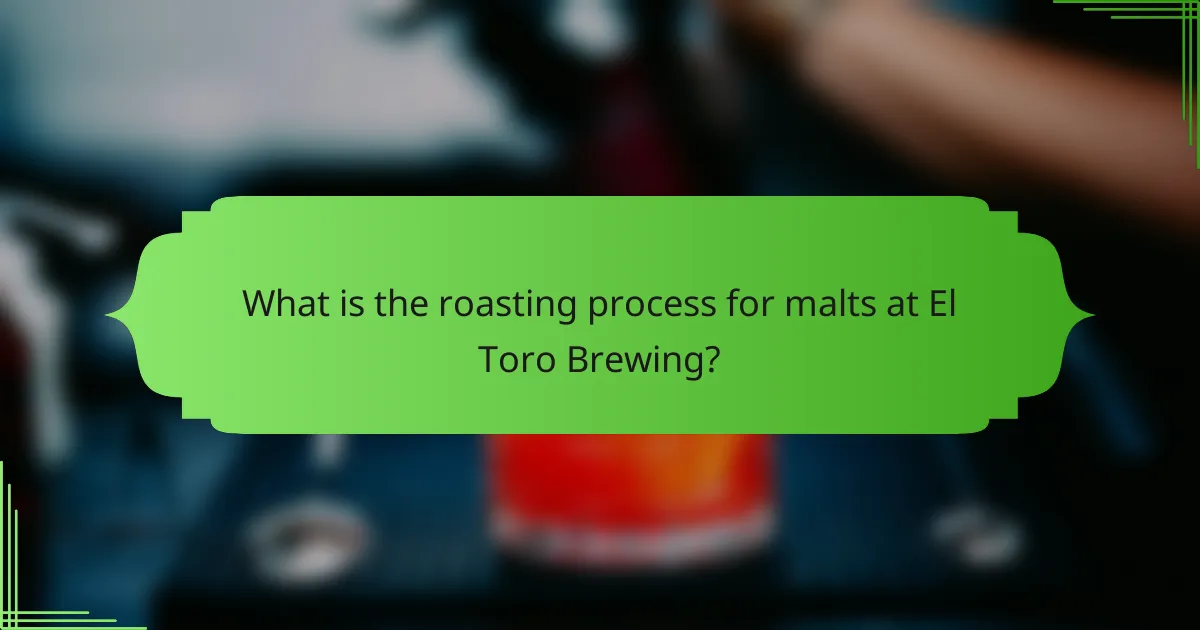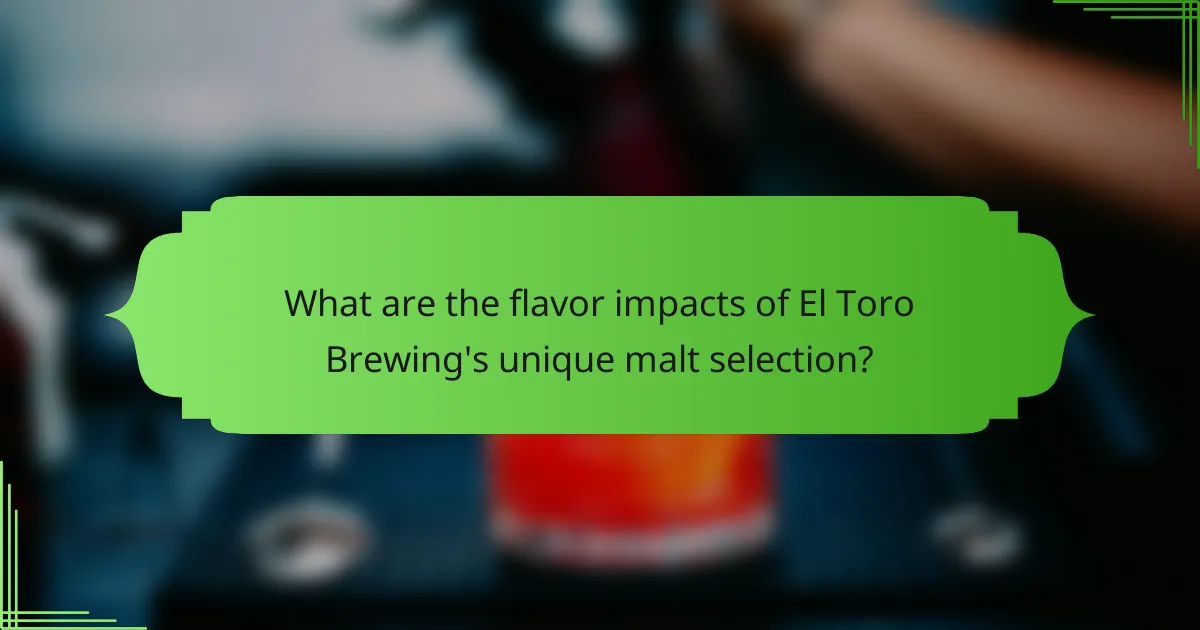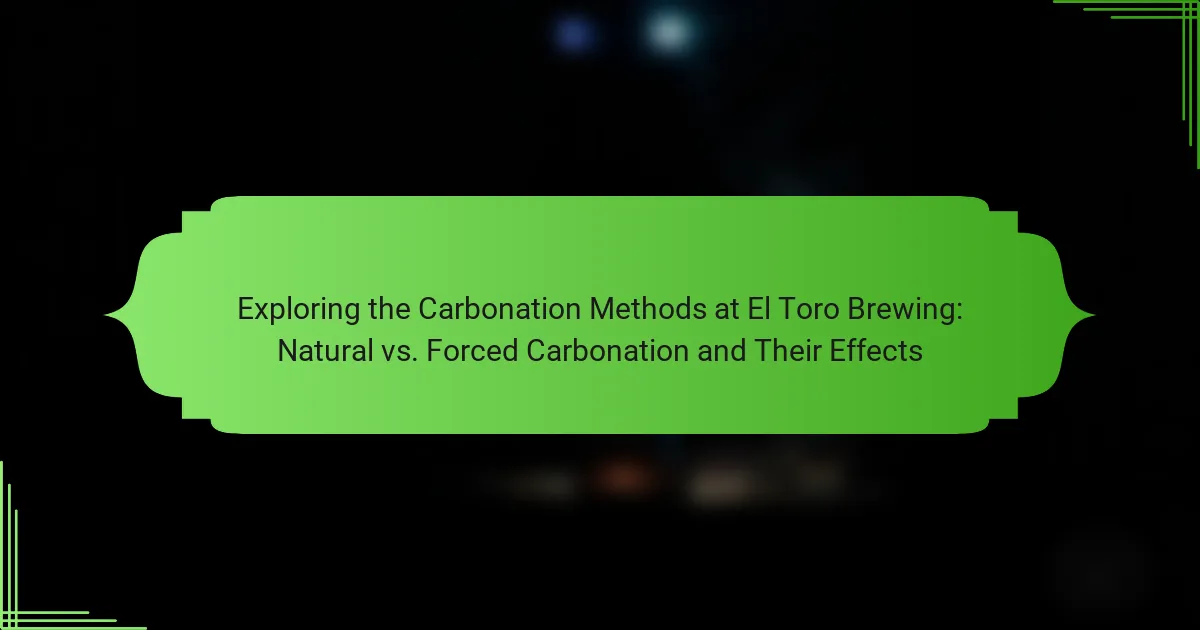El Toro Brewing specializes in crafting beers with a unique malt selection that includes both base and specialty malts. These malts are meticulously sourced to enhance the flavor profiles of their beers, providing foundational body and alcohol content while contributing distinct flavors and colors. The roasting process involves controlled heating, leading to caramelization and Maillard reactions that develop complex flavors and aromas. Lighter roasts produce sweeter notes, while darker roasts yield richer chocolate and coffee flavors. This detailed approach to malt selection and roasting plays a crucial role in achieving the signature taste of El Toro Brewing’s offerings.

What is El Toro Brewing’s Unique Malt Selection?
El Toro Brewing’s unique malt selection consists of a variety of specially sourced malts. These malts are chosen to enhance the flavor profile of their beers. The selection includes both base malts and specialty malts. Base malts provide the foundation for the beer’s body and alcohol content. Specialty malts contribute unique flavors and colors. El Toro Brewing emphasizes quality and consistency in their malt sourcing. This dedication ensures that each batch of beer maintains its distinctive taste. The unique malt selection plays a crucial role in creating their signature brews.
How does El Toro Brewing define its malt selection process?
El Toro Brewing defines its malt selection process as a meticulous evaluation of quality and flavor profiles. They prioritize sourcing malts from reputable suppliers known for consistency. Each malt is assessed for its specific attributes, such as color and sweetness. The brewing team conducts taste tests to ensure compatibility with their beer styles. They also consider the roasting process, which affects the final flavor. This thorough approach allows El Toro Brewing to create distinct and balanced beers. Their commitment to quality is evident in the final product, which consistently meets customer expectations.
What criteria are used to select malts at El Toro Brewing?
El Toro Brewing selects malts based on quality, flavor profile, and suitability for specific beer styles. Quality is assessed through sourcing from reputable suppliers. Flavor profile is evaluated to ensure it aligns with the desired taste of the final product. Suitability considers how the malt interacts with other ingredients in the brewing process. Each malt’s roasting level is also a critical factor. This ensures the final beer achieves the intended aroma and color. The selection process is integral to El Toro Brewing’s commitment to craft excellence.
How does the malt selection influence the brewing process?
Malt selection significantly influences the brewing process by determining the flavor, color, and body of the beer. Different types of malt contribute unique characteristics. For example, pale malts provide a light, crisp base flavor. Dark malts, on the other hand, impart rich, roasted flavors and deeper colors. The degree of roasting affects sugar content and caramelization, impacting sweetness and mouthfeel. Additionally, malt selection influences the fermentation process by providing fermentable sugars. The enzymes present in malt help convert starches into sugars during mashing. This process is crucial for achieving the desired alcohol content and overall balance in the final product. Therefore, careful malt selection is essential for crafting distinct and flavorful beers.
What types of malts are included in El Toro Brewing’s selection?
El Toro Brewing includes a variety of malts in its selection. The types of malts feature pale malt, caramel malt, and roasted malt. Pale malt serves as the base for many of their beers. Caramel malt adds sweetness and color to the brews. Roasted malt contributes to darker flavors and aromas. Each malt type plays a crucial role in the overall flavor profile. The combination of these malts enhances the uniqueness of El Toro Brewing’s offerings.
What are the different categories of malts used by El Toro Brewing?
El Toro Brewing uses several categories of malts including base malts, specialty malts, and roasted malts. Base malts serve as the foundation for most of their beers. Specialty malts add unique flavors and colors to the brews. Roasted malts contribute to the darker beers, enhancing bitterness and aroma. Each category plays a crucial role in the brewing process. The selection of these malts influences the final taste and character of the beers produced by El Toro Brewing.
How do these malt types contribute to the overall flavor profile?
Malt types significantly contribute to the overall flavor profile of beer. Different malts impart distinct flavors and aromas. For example, pale malts provide a light, biscuity taste. Crystal malts add sweetness and caramel notes. Roasted malts introduce coffee and chocolate flavors. Each malt type affects the beer’s color, mouthfeel, and complexity. The combination of these malts creates a balanced and unique flavor experience. Understanding malt selection is crucial for brewers to achieve desired flavor outcomes.

What is the roasting process for malts at El Toro Brewing?
The roasting process for malts at El Toro Brewing involves several key steps. First, the malts are carefully selected based on their desired flavor profiles. Next, they are heated in a roasting drum at controlled temperatures. This process typically ranges from 300 to 450 degrees Fahrenheit. The duration of roasting can vary from 15 minutes to several hours.
During roasting, the malts undergo caramelization and Maillard reactions. These reactions develop the complex flavors and aromas characteristic of the final product. The specific temperature and time combinations create different malt varieties. For example, lighter roasts produce sweeter, biscuit-like flavors. Darker roasts yield richer, chocolate or coffee notes.
El Toro Brewing’s attention to detail in the roasting process ensures unique flavor impacts in their beers. This meticulous method contributes to the overall quality and distinctiveness of their brewing style.
How is the roasting process conducted at El Toro Brewing?
The roasting process at El Toro Brewing involves precise temperature control and timing. First, the malts are heated in a roaster. This equipment evenly distributes heat to achieve desired roast levels. The process typically begins at lower temperatures to develop base flavors. As roasting progresses, temperatures increase to caramelize sugars. This step enhances flavor complexity and aroma. Finally, the roasted malts are cooled rapidly to stop the cooking process. This careful management ensures consistency and quality in the final product. El Toro Brewing’s roasting technique contributes to their unique flavor profiles in beers.
What equipment is utilized in the malt roasting process?
The equipment utilized in the malt roasting process includes a malt roaster. A malt roaster is specifically designed to heat and roast malted grains. This equipment operates by circulating hot air around the grains to achieve desired roasting levels. The temperature and duration of roasting can be precisely controlled. Additionally, some facilities may use a kiln for larger batches. The kiln allows for even heat distribution and consistent results. These pieces of equipment are essential for developing the flavor profiles in malt. Proper use of this equipment influences the final taste of the brewed beverage.
How does the roasting time affect the final malt characteristics?
Roasting time significantly influences the final malt characteristics. Longer roasting times typically result in darker malts. Darker malts often possess stronger flavors, such as chocolate or coffee notes. They also exhibit increased bitterness levels. Conversely, shorter roasting times yield lighter malts. These lighter malts tend to have sweeter and more delicate flavors. Additionally, the Maillard reaction intensifies with longer roasting. This reaction contributes to the complex aroma and flavor profile of the malt. Research indicates that specific roasting durations can create distinct sensory profiles in beer.
Why is the roasting temperature important in malt selection?
Roasting temperature is crucial in malt selection as it directly influences the flavor profile and color of the malt. Higher roasting temperatures typically produce darker malts with richer, more complex flavors. These flavors can range from chocolate and coffee notes to caramel and nutty undertones. Conversely, lower temperatures yield lighter malts with milder, more delicate flavors. The Maillard reaction, which occurs at elevated temperatures, contributes to the development of these flavors during roasting. Additionally, the roasting temperature affects the enzymatic activity within the malt, impacting its fermentability. Therefore, selecting the appropriate roasting temperature is essential for achieving desired taste characteristics in the final product.
What impact does temperature have on flavor development?
Temperature significantly influences flavor development in brewing. Higher temperatures during the roasting process enhance the Maillard reaction. This reaction creates complex flavors and aromas in malt. Conversely, lower temperatures tend to produce milder, less intense flavors. The choice of temperature also affects the caramelization of sugars. This process can lead to sweeter, more pronounced flavor profiles. Research shows that optimal roasting temperatures range from 300°F to 400°F. These temperatures yield a balance of sweetness and bitterness in the final product. Thus, temperature is a critical factor in determining the flavor characteristics of malt.
How does roasting temperature vary for different malt types?
Roasting temperature varies significantly among different malt types. Base malts are typically roasted at lower temperatures, around 150-160°C. Specialty malts, such as caramel malts, require higher temperatures, often between 160-200°C. Dark malts, like chocolate and black malts, are roasted at even higher temperatures, ranging from 200-230°C. Each malt type’s roasting temperature affects its flavor profile and color. For instance, lower temperatures yield lighter flavors, while higher temperatures produce more intense, roasted flavors. This variation is essential for achieving desired taste and aroma in the final beer product.

What are the flavor impacts of El Toro Brewing’s unique malt selection?
El Toro Brewing’s unique malt selection significantly influences the flavor profile of its beers. The selection includes a variety of malts that contribute distinct tastes and aromas. For example, caramel malts add sweetness and toasty notes. Roasted malts provide chocolate and coffee flavors. Specialty malts enhance complexity with hints of fruit or spice. The roasting process further intensifies these flavors, impacting the overall beer character. Each malt type is carefully chosen to achieve a balanced and rich flavor experience. This meticulous selection process is evident in the unique taste profiles of El Toro’s offerings.
How do different malts affect the flavor of the final product?
Different malts significantly influence the flavor of the final product. Each malt type contributes unique taste profiles based on its characteristics. For instance, pale malts provide a light, biscuity flavor. Munich malts add a rich, malty sweetness. Crystal malts introduce caramel notes, enhancing complexity. Roasted malts impart chocolate or coffee flavors, adding depth. The roasting process also alters flavor; darker malts typically yield more intense, bitter flavors. The combination of various malts allows brewers to craft distinct flavor profiles tailored to specific styles. Thus, the selection and treatment of malts are crucial for achieving desired taste outcomes in brewing.
What specific flavors can be expected from each malt type?
Pale malt typically imparts a light, biscuity flavor. It serves as the base for many beers. Munich malt adds a rich, malty sweetness with a hint of bread. This malt enhances the overall body of the beer. Crystal malt contributes caramel and toffee notes. It provides sweetness and color to various styles. Chocolate malt delivers deep, roasted flavors reminiscent of dark chocolate. This malt is essential for stouts and porters. Black malt offers intense bitterness and coffee-like flavors. It is used sparingly due to its strong impact. Each malt type plays a crucial role in defining the beer’s flavor profile.
How do the roasting process and malt types work together to create unique flavors?
The roasting process and malt types work together to create unique flavors by altering the chemical composition of the grains. Different malt types, such as pale, caramel, and roasted malts, contribute distinct base flavors. The roasting process affects sugars and amino acids, leading to caramelization and Maillard reactions. These reactions produce a variety of flavor compounds, including nutty, chocolate, and coffee notes. For example, lighter malts provide biscuity flavors, while darker malts add bitterness and depth. The duration and temperature of roasting also influence the final taste profile. Longer roasting times generally yield more intense flavors. Thus, the combination of malt selection and roasting techniques results in a diverse range of flavors in the final brew.
What role does malt selection play in beer style development?
Malt selection is crucial in beer style development. Different malts contribute unique flavors, colors, and aromas to the beer. Base malts provide the fermentable sugars needed for alcohol production. Specialty malts add complexity and depth to the flavor profile. For example, caramel malts impart sweetness and color, while roasted malts add bitterness and dark hues. The choice of malt also influences mouthfeel and body. Each beer style typically favors specific malt types to achieve its characteristic taste. Historical brewing traditions often dictate malt preferences for certain styles. Therefore, malt selection directly shapes the overall identity of the beer.
How does malt choice influence the characteristics of various beer styles?
Malt choice significantly influences the flavor, color, and body of various beer styles. Different malts contribute distinct characteristics to the final product. For example, pale malts are commonly used in lighter beer styles, providing a clean, crisp flavor. Dark malts, on the other hand, add rich flavors and darker colors, essential for stouts and porters. Specialty malts can impart unique flavors such as caramel, chocolate, or nutty notes. The roasting process affects the malt’s enzymes and sugars, which in turn impacts fermentation and overall beer profile. Moreover, the choice of malt can alter the beer’s mouthfeel, with some malts enhancing creaminess or dryness. Overall, the selection of malt is crucial in defining the style and taste of the beer.
What examples illustrate the impact of malt selection on beer flavor?
Malt selection significantly impacts beer flavor. For example, pale malts contribute a light, biscuity flavor. These malts serve as the base for many ales and lagers. Dark malts, such as chocolate or roasted malts, add flavors of coffee and chocolate. These malts are often used in stouts and porters. Specialty malts can introduce caramel, toffee, or nutty notes. Variations in roasting levels also affect flavor; lightly roasted malts are sweeter, while heavily roasted malts are more bitter. The choice of malt influences the beer’s color, aroma, and overall taste profile.
What are best practices for selecting and roasting malts in brewing?
Select malts based on the desired flavor profile and beer style. Consider the base malts for foundational flavors. Specialty malts add complexity and unique characteristics. Evaluate malt quality by checking for freshness and consistency. Roasting malts requires precise temperature control to achieve specific flavors. Monitor time closely to avoid over-roasting. Use a variety of malts to create depth in flavor. Experiment with different combinations for unique results. Consistent practice and tasting help refine the roasting process.
El Toro Brewing is the main entity discussed in this article, focusing on its unique malt selection and its impact on brewing. The article outlines the types of malts used, including base, specialty, and roasted malts, and details the meticulous selection and roasting processes that influence flavor profiles. Key attributes such as quality assessment, roasting temperature, and time are examined to highlight their roles in developing distinct beer characteristics. Additionally, the article emphasizes how different malt types contribute to the overall flavor, color, and mouthfeel of the final product, showcasing El Toro Brewing’s commitment to craft excellence.


